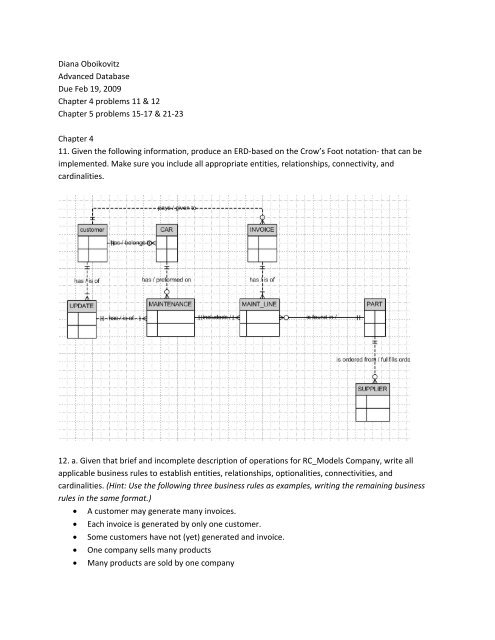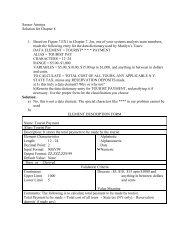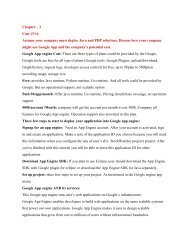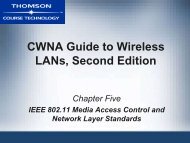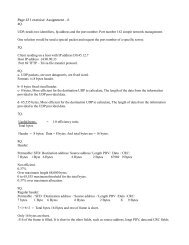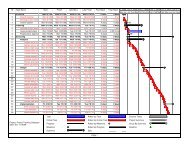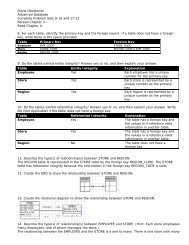ADVANCED DATABASE Chapter 4 problems 11 & 12 5 ... - Csmaster
ADVANCED DATABASE Chapter 4 problems 11 & 12 5 ... - Csmaster
ADVANCED DATABASE Chapter 4 problems 11 & 12 5 ... - Csmaster
Create successful ePaper yourself
Turn your PDF publications into a flip-book with our unique Google optimized e-Paper software.
Diana Oboikovitz<br />
Advanced Database<br />
Due Feb 19, 2009<br />
<strong>Chapter</strong> 4 <strong>problems</strong> <strong>11</strong> & <strong>12</strong><br />
<strong>Chapter</strong> 5 <strong>problems</strong> 15‐17 & 21‐23<br />
<strong>Chapter</strong> 4<br />
<strong>11</strong>. Given the following information, produce an ERD‐based on the Crow’s Foot notation‐ that can be<br />
implemented. Make sure you include all appropriate entities, relationships, connectivity, and<br />
cardinalities.<br />
<strong>12</strong>. a. Given that brief and incomplete description of operations for RC_Models Company, write all<br />
applicable business rules to establish entities, relationships, optionalities, connectivities, and<br />
cardinalities. (Hint: Use the following three business rules as examples, writing the remaining business<br />
rules in the same format.)<br />
• A customer may generate many invoices.<br />
• Each invoice is generated by only one customer.<br />
• Some customers have not (yet) generated and invoice.<br />
• One company sells many products<br />
• Many products are sold by one company
• Many customers pay by only credit card (does not define if a customer can pay by many credit<br />
cards)<br />
• Each credit card payment is generated by one customer<br />
• Each invoice has many products<br />
• One or more products are printed on each invoice<br />
• Zero to many products are tracked in inventory by date last used<br />
• Inventory has zero to many products<br />
• Products in inventory less then 4 weeks are kept<br />
• Products in inventory greater then 4 weeks are scrapped<br />
• Inventory has zero to many orders<br />
• Orders may or may not be placed depending on quantizes<br />
• Products have one or more manufactures<br />
• Manufactures may or may not have supplied parts<br />
b. Draw the fully labeled and implementable Crow’s Foot ERD based on the business rules you<br />
wrote in Part (a) of this problem. Include all entities, relationships, optionalities, connectivities, and<br />
cardinalities.
<strong>Chapter</strong> 5<br />
15. Given the table structure illustrated in Table P5.15, write the relational schema and draw its<br />
dependency diagram. Label all transitive and /or partial dependencies. (Hint: This structure uses a<br />
composite primary key).<br />
1NF :<br />
(MEMBER_NUM, INVITE_NUM, MEMBER_NAME, MEMBER_ADDRESS, MEMBER_CITY,<br />
MEMBER_ZIPCODE, INVITE_DATE, ACCEPT_DATE, DINNER_DATE, DINNER_ATTEND, DINNER_CODE,
DINNER_DESCRIPTION, ENTRÉE_CODE, ENTRÉE_DESCRIPTION, DESSERT_CODE,<br />
DESSERT_DESCRIPTION)<br />
Partial dependencies:<br />
1. (MEMBER_NUM ‐> MEMBER_NAME, MEMBER_ADDRESS, MEMBER_CITY,<br />
MEMBER_ZIPCODE)<br />
2. (INVITE_NUM ‐ > INVITE_DATE, ACCEPT_DATE, DINNER_DATE)<br />
3. (DINNER_CODE ‐> DINNER_DESCRIPTION, ENTRÉE_CODE, ENTRÉE_DESCRIPTION,<br />
DESSERT_CODE, DESSERT_DESCRIPTION)<br />
Transitive dependency:<br />
1. (DINNER_DATE ‐> INVITE_DATE)<br />
16. Break up the dependency diagram you drew in Problem 15 to produce dependency diagrams that<br />
are in 3NF and write the relational schema. (Hint: You might have to create a few new attributes. Also<br />
make sure that the new dependency diagrams contain attributes that meet proper design criteria; that<br />
is, make sure that there are not multi‐valued attributes, that the naming conventions are met, and so<br />
on.)<br />
(MEMBER_NUM, INVITE_NUM, MEMBER_NAME, MEMBER_ADDRESS, MEMBER_CITY,<br />
MEMBER_ZIPCODE, INVITE_DATE, ACCEPT_DATE, DINNER_DATE, DINNER_ATTEND, DINNER_CODE,<br />
DINNER_DESCRIPTION, ENTRÉE_CODE, ENTRÉE_DESCRIPTION, DESSERT_CODE, DESSERT_DESCRIPTION)<br />
MEMBER (MEMBER_NUM, MEMBER_NAME, MEMBER_ADDRESS, MEMBER_CITY, MEMBER_ZIPCODE)<br />
INVITE (INVITE_NUM, MEMBER_NUN, ACCEPT_DATE, DINNER_DATE, DINNER_ATTEND)<br />
DINNER (DINNER_CODE, DINNER_DESCRIPTION, ENTRÉE_CODE, DESSERT_CODE)<br />
ENTRÉE (ENTRÉE_CODE, ENTRÉE_DESCRIPTION)<br />
DESSERT (DESSERT_CODE, DESSERT_DESCRIPTION)<br />
SCHEDULE (SCH_NUM, MEMBER_NUM, INVITE_NUM, DINNER_CODE, MEMBER_STATUS)<br />
DATE (DINNER_DATE, INVITE_DATE)
17. Using the results of Problem 16, draw the Crow’s Foot ERD.
21. Given the sample records in the CHARTER table shown in Table P5.21, write the relational schema<br />
and draw the dependency diagram for the table structure.<br />
1NF:<br />
(CHAR_TRIP, CUST_NUM, AC_NUMBER, CHAR_DATE, CHAR_CITY, CHAR_MILES, CUST_LNAME,<br />
CHAR_PAX, CHAR_CARGO, PILOT, COPILOT, FLT_ENGINEER, LOAD_MASTER, AC_NUMBER,<br />
MODEL_CODE, MODEL_SEATS, MODEL_CHG_MILE)
Partial dependencies:<br />
1. (CHAR_TRIP‐> CHAR_DATE, CHAR_CITY, CHAR_MILES, CHAR_PAX, CHAR_CARGO)<br />
2. (CUST_NUM‐> CUST_LNAME)<br />
3. (AC_NUMBER‐> MODEL_CODE, MODEL_SEATS, MODEL_CHG_MILE)<br />
4. (CHAR_TRIP ‐> PILOT, COPILOT, FLT_ENGINEER, LOAD_MASTER)<br />
22. Decompose the dependency diagram you drew to solve Problem 21 to create table structures that<br />
are in 3NF and write the relational schema. Make sure that you label all dependencies.<br />
(CHAR_TRIP, CUST_NUM, AC_NUMBER, CHAR_DATE, CHAR_CITY, CHAR_MILES, CUST_LNAME,<br />
CHAR_PAX, CHAR_CARGO, PILOT, COPILOT, FLT_ENGINEER, LOAD_MASTER, AC_NUMBER,<br />
MODEL_CODE, MODEL_SEATS, MODEL_CHG_MILE)<br />
TRIP (CHAR_TRIP, CHAR_DATE, CHAR_CITY, CHAR_MILES, CHAR_PAX, CHAR_CARGO,<br />
CREW ( CHAR_TRIP, AC_NUMBER, CREW_PILOT, CREW_COPILOT, CREW_ FLT_ENGINEER,<br />
CREW_LOAD_MASTER)<br />
AIRPLANE (AC_NUMBER, MODEL_CODE, MODEL_SEATS, MODEL_CHG_MILE)<br />
23. Draw the Crow’s Foot ERD to reflect the properly decomposed dependency diagrams you created in<br />
Problem 22. Make sure that the ERD yields a database that can track all of the data shown in Problem<br />
21. Show all entities, relationships, connectivities, optionalities, and cardinalities.


